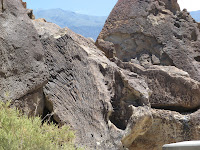
"I only went out for a walk and finally concluded to stay out until sundown, for going out, I found, was really going in." - John Muir
So reads the sign at the Sabrina Basin trailhead that leads into the John Muir Wilderness of the Inyo National Forest, a 20 minute drive up my street. Brent and I headed out on the trail for a single night backpacking trip. The trail begins just below the Lake Sabrina dam at 9,125' elevation and follows the lake through aspen and willows, becoming sagebrush scrub dotted with conifers and covered with wildflowers this time of year. Continuing higher, you pass through lodgepole pine forest and the trail steepens with switchbacks cut into the granite. We finally reached Blue Lake, only 3 miles in but at 10,400', had lunch, and decided to set up camp there. After a refreshing nap, we set out much lighter and followed a trail to Emerald Lakes, giving us stunning views of the peaks surrounding the Basin and more alpine wildflowers.
Bird list: song sparrow, yellow warbler, brown-headed cowbird, dark-eyed junco, mountain chickadee, Clark's nutcracker, red-breasted sapsucker, brown creeper, Cassin's finch, dusky flycatcher, yellow-rumped warbler, golden eagle, Steller's jay, western wood pewee, olive-sided flycatcher, northern flicker.
More pictures are available
here. Enjoy !
































































